Richardson: I was adamant Chapman had a conflict. The Ombudsman says she didn’t
Last year, Tom Richardson argued that the then-Attorney-General and Deputy Premier had a “textbook” clear case of perceived conflict of interest in relation to her decision to veto a $40 million timber port. This week the state’s Ombudsman disagreed, completely.
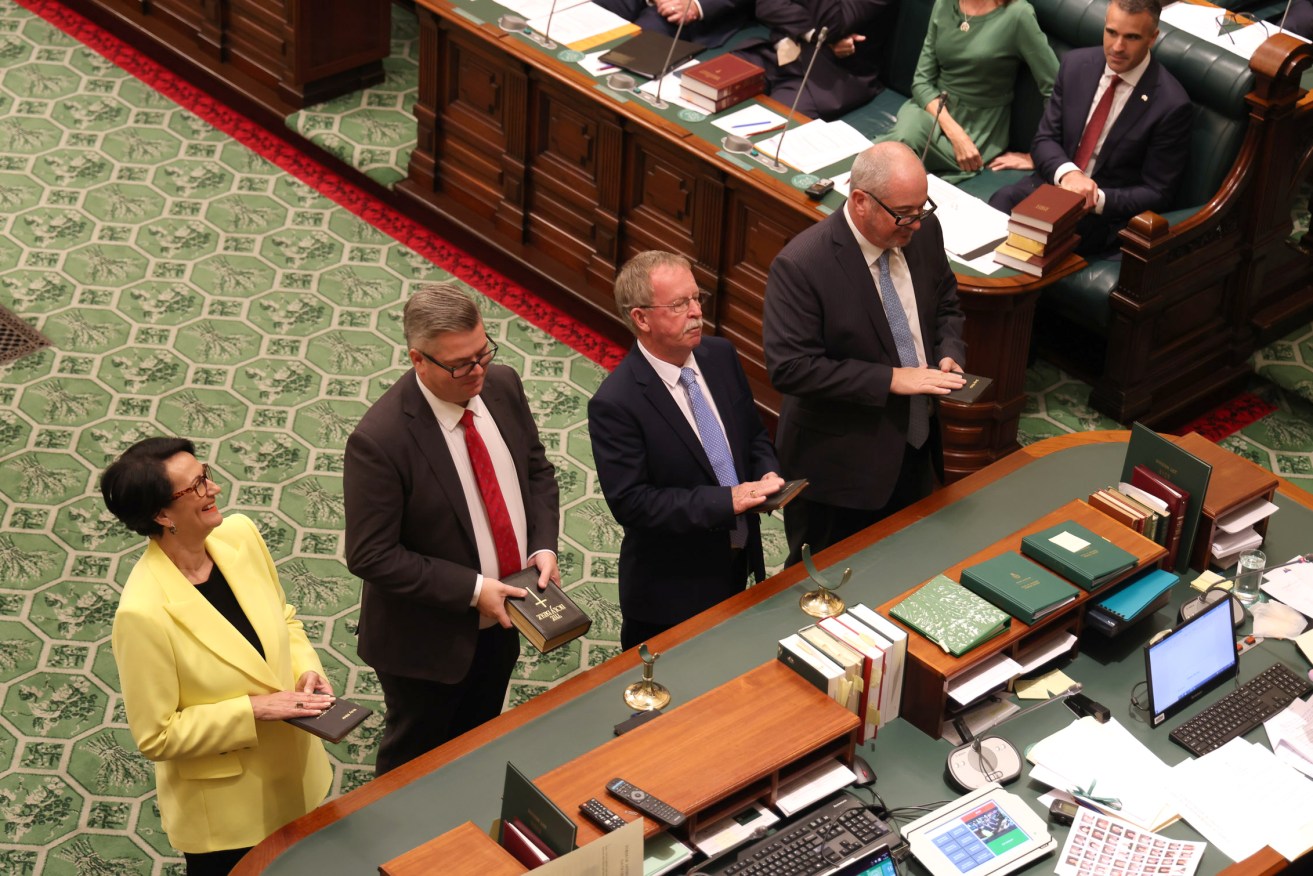
Vickie Chapman has a moment of levity during her controversial swearing-in this week. Photo: Tony Lewis / InDaily
The Vickie Chapman era of state politics was never going to end with a whimper.
I recall the then-Premier Mike Rann once damning with faint praise the parole board chair Frances Nelson QC, a frequent thorn in his government’s side, by declaring that public life needed a few such colourful characters.
Nelson, aptly enough, was Chapman’s legal counsel through much of her recent travails.
And Rann was right: SA’s public life must have its characters. And Vickie has certainly been one of them.
I’ll always chuckle to recall the note she sent my infant son on his 2011 birth: “Welcome to the world; I sincerely hope you look like your mother.”
(He does; lucky boy!)
Until earlier this week, the Chapman era looked set to end in ignominy – turfed from parliament after an impulsive resignation proved a few weeks premature (for the record: if the Crown Law advice is correct, it needs changing; there is no reason I can countenance that a long-serving MP cannot nominate their chosen date of departure in a formal resignation, just as the rest of us can).
But a long-awaited Ombudsman’s inquiry report provided (at least) one final twist; the finding of last year’s select committee that found Chapman had both real and perceived conflicts of interest when she vetoed a major port development on her native Kangaroo Island was rejected. Utterly.
Instead, Wayne Lines determined there was no conflict, whatsoever.
Not actual. Not perceived. Not potential.
Nothing.
That’s a pretty comprehensive slap down.
No actual
No perceived
Not even a potential conflict of interest
What a waste of time and taxpayers money. https://t.co/3JyyjzWsAK
— Laura Jayes (@ljayes) May 3, 2022
It would be counter-intuitive to claim this wasn’t a surprise to me.
I had, after all, written last November – before the Ombudsman’s inquiry was even countenanced – that the issue of perceived conflict being hotly debated inside parliament’s walls was not “some line-ball judgment call that requires two weeks of public hearings to reach a tenuous conclusion”, nor “a ‘he said/she said’ political spat”.
“It is,” I wrote, “textbook… about as clear a case, I’d suggest, of perceived conflict of interest as you are ever likely to encounter in public life.”
This week, the state’s Ombudsman entirely disagreed with my assessment.
I have to wear that, and I will.
So too must I live with my jab that Chapman, the archetypal political fighter, seemingly intended to slug it out “in her own inimitable style… namely, to look at all the objective facts and insist they point to an entirely different conclusion than that which appears blindingly clear to almost everyone else”.
But not, as it happens, to the one man tasked with adjudicating the matter.
So do I owe Vickie Chapman an apology?
I’d argue probably not – but we’ll come to that in due course.
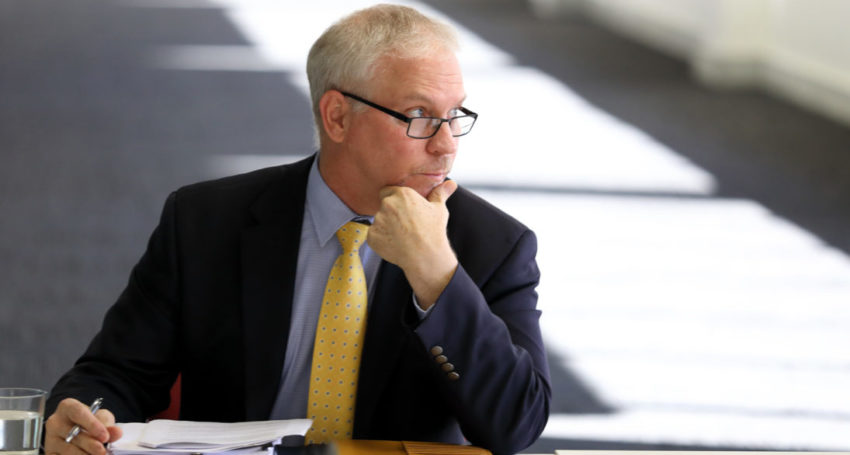
SA Ombudsman Wayne Lines. Photo: Tony Lewis / InDaily
Because the important thing is that this is not the end of it.
If I was wrong, so were a great number of people: not least a noted QC, at least one former Attorney-General, the majority of state parliament’s House of Assembly and, of course, three of the five members of a parliamentary select committee.
Oh, and – conspicuously, and by his own admission this week – the current Leader of the Opposition.
Not to mention a great many members of the general public – whose view, I had long understood, was crucial to the perception of conflict of interest.
That understanding now requires reassessment.
It’s hard to escape the conclusion that under this definition it would be virtually impossible to ever make a finding of perceived conflict of interest
Because this much seems clear: the interpretation adopted in the Ombudsman’s findings seems to dramatically – fundamentally – raise the bar on what was broadly understood to qualify as perceived conflict of interest in this state.
The landscape is now changed.
The rationale under which last year’s committee made its finding of a perception of conflict – putting aside the questions of real conflict, which Lines also rejected – was stated under privilege to the inquiry by former Kangaroo Island Plantation Timbers executive Shauna Black: “I cannot see how a reasonable person could dispute that [Chapman] had, at the very least, a perceived conflict of interest.”
“I say this,” Black went on, “because of her landholdings, their proximity to the plantations, her close relationship with [mayor and outspoken opponent of the project Michael] Pengilly and also because of the numerous people from the island, the state, and wider Australia, who are convinced that she had a conflict.
“But perhaps the greatest source of the perceived conflict is that both Mr Pengilly and Minister Chapman belonged to a small cohort of farmers on the island who have conflated their long-held resentment of plantation forestry with the matter of the Smith Bay port.”
Lines’ report, then, disregards the suggestion that because a conflict is – as Black claims – widely perceived, that it is a perceived conflict.
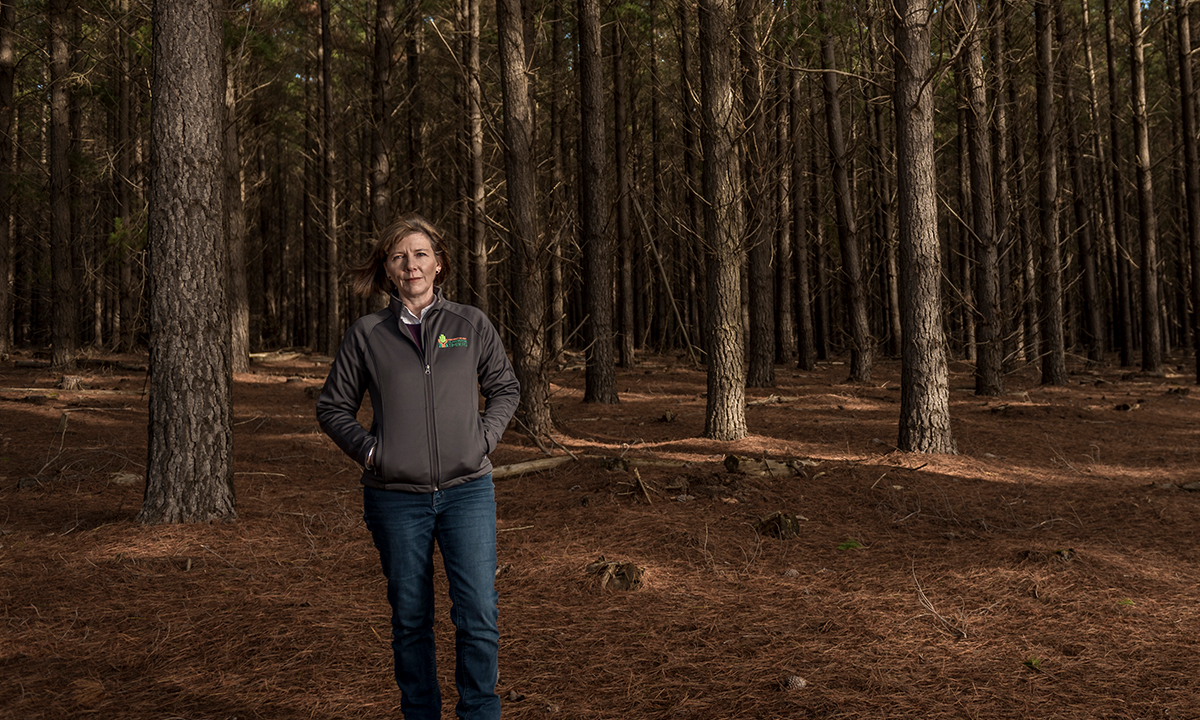
Former KIPT executive Shauna Black. Photo: Sean McGowan
But I did not choose my words lightly last year.
I listened to all the evidence put forward in that inquiry – every word, every minute – and I wrestled with the propriety of making a public judgment call.
As such, I’ve considered Wayne Lines’ contrary finding with equal care.
I described the perceived conflict as ‘textbook’.
But Lines determined that no such textbook existed.
The Ombudsman’s findings dramatically – fundamentally – raise the bar on what was broadly understood to qualify as perceived conflict of interest
This too is important.
He does not begin with a defined interpretation of perceived conflict of interest; rather, he builds one along the way.
In his report, he seemed crestfallen that having been charged to determine whether the A-G had committed maladministration or breached the ministerial code by her assumed conflict of interest, he was in effect being asked to re-prosecute the case as to whether such a conflict existed in the first place.
This, nonetheless, he set about diligently, taking great care to ponder the distinction between real and perceived conflicts of interest – and lamenting the lack of a clear definition.
“The Ministerial Code of Conduct does not provide any guidance on how a perceived conflict of interest is to be identified,” he complains.
“I must therefore consider the following: from whose perspective is a conflict of interest perceived? How suspicious is the fictional observer, and what information are they expected to possess?”
His starting point is a missive from which I quoted last year: a circular from Independent Commissioner Against Corruption Ann Vanstone to SA’s public service, informing them all: “A public officer has a conflict of interest when a ‘fair and reasonable’ person could perceive them as having one.”
“If a reasonable and fair-minded observer might perceive that a public officer’s personal interest could be favoured by exercising their duties and responsibilities, then a conflict of interest exists,” she wrote.
“Perception is an important consideration when identifying conflicts of interest, and the reasonable person test should always be considered when seeking to identify the existence of conflicts of interest.”
In Vanstone’s paper, that is the broad characterisation of perceived conflict. Lines, though, takes it merely as his “starting point… the perspective of a reasonable and fair-minded person”.
He then turns to consider “what information this fictional observer possesses” – arguably the key question in his findings – but discovers very little advice on the topic. While “almost all Australian jurisdictions include perceived or apparent conflicts of interest in their ministerial codes of conduct”, he laments that almost none address his specific question.
He finds succour, however, on the Apple Isle.
“Only Tasmania offers guidance on this question… the Tasmanian Code of Conduct provides that ‘a material conflict of interest is one that is significant or important, or one which a reasonable person would think is important to the Minister’s official duties or to a decision to be made by the Minister’.
“‘A Minister must think about and declare any facts or interests that a reasonable person in the same or similar circumstances would be expected to know to be relevant to the issues at hand or to a decision to be made.’”
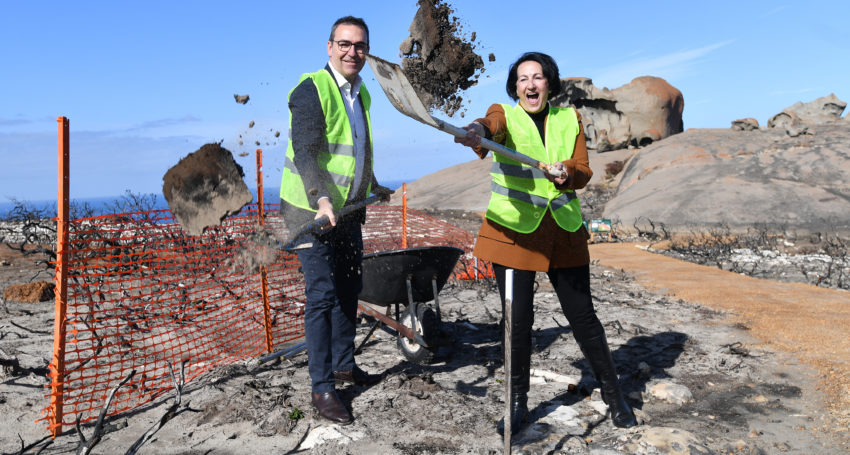
Then-Premier Steven Marshall and his deputy Vickie Chapman take a shovel to the soil on kangaroo Island, where the Ombudsman did some digging of his own. Photo: David Mariuz / AAP
Lines went digging yet further, excavating the first written code of conduct for ministers in SA, published in 1988 – though, sadly again, it held “very little guidance… to determine how a perceived conflict of interest might be identified”.
Still, things were looking up: “In 1993, a Cabinet Handbook was adopted to provide more specific guidance to ministers.”
Hurrah!
The 1993 Handbook provided that “a conflict will arise whenever a reasonable person, who knows what the Minister knows, would believe there is a substantial and unjustifiable risk of conflict between the public duties of the Minister and the Minister’s personal interests”.
“One of the tests for conflict is that of appearance: does the appearance look, to the reasonable person, to be the sort of interest that may influence,” the ’93 handbook continues.
“A Minister is taken to know the facts which the Minister would have found out had he or she made such further inquiry as the facts in his or her possession clearly required.”
Whatever that means.
Lines concluded that this hypothetical “reasonable person imagined by the 1993 Handbook was afforded a great deal of information”.
“Their gaze extended beyond what is publicly available, and even what is directly before the Minister,” he postulated.
I’ve never considered Chapman was seeking or stood to gain any personal financial benefit
But oh, calamity! For Lines’ exhaustive search for his archetypal “reasonable person” proved “short-lived”.
The cabinet handbook was amended a mere year after publication, with a ministerial code of conduct provided in its appendix – both of which “provided substantially less guidance on conflicts of interest, and only referred to actual and potential conflicts”.
Pfft.
Even (or rather, particularly) the current Ministerial Code, adopted in 2002, “does not reach the high-water mark set by the 1993 Handbook”.
Still, Lines is deliberately “reluctant to conclude that the reasonable observer imagined in the 1993 Handbook is the appropriate test in this matter, given that a similar standard is not replicated elsewhere”.
“In all of the circumstances, I consider that a perceived conflict of interest ought to be identified from the perspective of an observer who is reasonable and fair-minded, understands and appreciates the importance of the relevant interest and the decision at hand [and] possesses knowledge of the facts, interests and issues that they would reasonably be expected to know in the circumstances.”
And yet, in approaching the question of perceived conflict, he appears to go back to a very precise interpretation of that 1993 handbook.
While he acknowledges questions around one of Chapman’s properties near a plantation affected by the port development – which was advertised on AirBNB, despite her insistence she was “not operating a B&B” – Lines found Chapman “has given a reasonable explanation as to how that came about and maintains that the property was not a tourist business at the time she considered the Smith Bay application”.
But even if it was, assessment reports suggest “that the economic impact on accommodation providers will be neutral” and don’t suggest “that the accessibility, amenity and enjoyment of the property would be impacted by the proposal”.
“In my view, even if I accept a reasonable observer may assume that the Gum Valley property provided tourist accommodation, there is no evidence on which to base an inference that the Smith Bay application would impact that type of business at that location either for better or worse,” Lines determined.
“Such an inference would be pure speculation besides being inconsistent with everything else that is generally known about the property, the timber plantation on Western River Road, the Smith Bay application and KIPT’s current timber salvaging operations.
“It is not an inference that could be attributed to a reasonable, fair-minded observer.
“In my view a reasonable, fair-minded observer would conclude that as the timber on the plantation opposite the property would be harvested regardless of whether the Smith Bay application is approved, the Smith Bay application is irrelevant to the way Ms Chapman uses her property.”
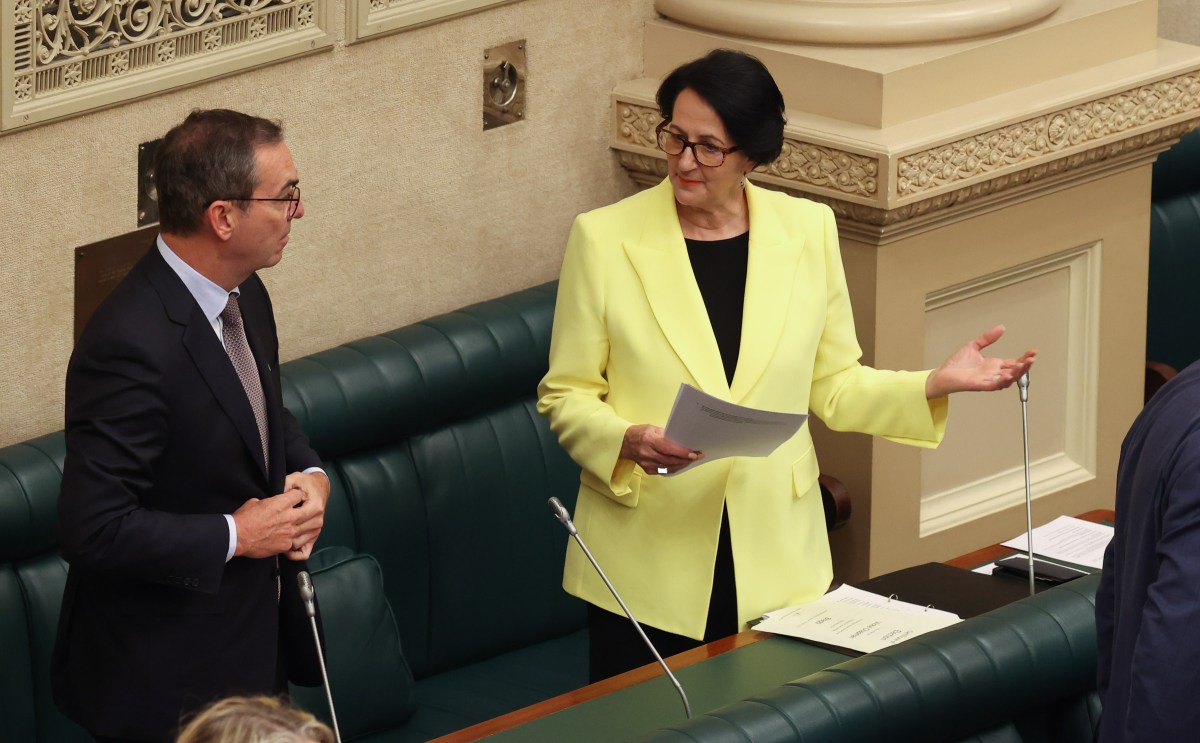
Vickie Chapman with former Premier Steven Marshall in parliament this week. Photo: Tony Lewis / InDaily
This “reasonable, fair-minded observer”, then, is expected to have, at the very least, familiarised themselves with various assessment reports and understood a similar level of detail about the proposal’s economic and environmental impact as the minister herself.
Which may well be the case, but it’s a level of detail not contained in other definitions of perceived conflict I’ve ever seen broadly disseminated.
There is a sense in which he appears to be waving a hypothetical damning report in the air
Also, for the record, I’ve never considered Chapman’s landholdings per se to be a crucial issue in this matter – and certainly never considered she was seeking or stood to gain any personal financial benefit.
Still, there were other factors the select committee leaned on to make its damning findings: one was Chapman’s close personal friendship, dating back to childhood, with local mayor Michael Pengilly – arguably the port project’s most outspoken opponent.
Another was the account of KIPT executives of a 2017 meeting with Pengilly – then a state Liberal MP – to which Chapman tuned up, not as a shadow minister or MP, but a landholder on the island. And, according to their accounts (which she disputed) proceeded to tell them the location of their proposed port – for which they had already purchased land – was the wrong place.
Lines found that neither of these points constituted a real or perceived conflict.
In relation to both, however, he raises the suggestion of a prospective “apprehension of bias”.
He then digresses to explain the distinction.
“It should be noted that conflict of interest is conceptually separate, albeit closely related to, bias or the apprehension of bias,” he explains.
“This is an important point to clarify, as a number of the authorities referred to and relied upon in the course of the Select Committee’s inquiry concern bias and not conflict of interest.”
He notes a NSW Ombudsman missive that suggests “the common law has tended to focus much more on bias than conflicts of interests”, noting “bias essentially refers to a failure to bring an impartial mind to the making of a decision”.
Indeed, it’s a term Chapman recently employed herself when, through her lawyer Frances Nelson QC, she accused committee member Tom Koutsantonis of the same, insisting he recuse himself from the inquiry’s deliberations.
“Bias can be the outcome or effect of a conflict of interests, but a conflict of interests is just one possible cause of bias,” Lines quotes.
“A conflict of interests is not necessarily misconduct – that depends on how it is managed and dealt with. On the other hand, bias in the performance of a public function is a form of misconduct.”
But he then goes on to point out that no-one asked him to investigate potential apprehended bias anyway – so it’s immaterial.
There is a sense in which he appears to be waving a hypothetical damning report in the air, while telling the committee: ‘This is what you might have got if you’d consulted me about my own terms of reference.’
At any rate, he declared any conflict of Chapman’s was a matter for her to determine – and pins the blame for the fact no-one raised the prospect of apprehended bias on KIPT’s executives.
He notes that Black’s scathing assessment of a broad perception of conflict was at odds with her evidence to an earlier committee, when she asserted Chapman “has not said anything in public that would lead us to believe that she opposes Smith Bay”.
Asked about this discrepancy in November, Black responded: “I think I chose my words wisely [previously] because the future of the company and the forestry industry on Kangaroo Island depended on Ms Chapman’s decision.”
But Lines appears to put significant weight on Black’s previous publicly-stated position.
“If Ms Black’s evidence to that Committee was not a true representation of her views, Ms Chapman cannot be expected to have known that,” he finds.
“Ms Chapman cannot be criticised for not anticipating that Ms Black and the other KIPT directors and executives held a view about her suitability to decide the Smith Bay application that was different to Ms Black’s public statement if they chose not to tell her.
“If KIPT’s executives and directors did not raise an apprehension of bias when they had opportunity to do so, it is not for me to now, in retrospect, find that they did have such an apprehension.”
Moreover, “the key point is that I am satisfied that Ms Chapman’s involvement in the 2017 meeting did not give rise to a conflict of interest [and] as the terms of the referral are limited to whether Ms Chapman was in a position of conflict between her private interests and private duty, I need not dwell on this issue any further”.
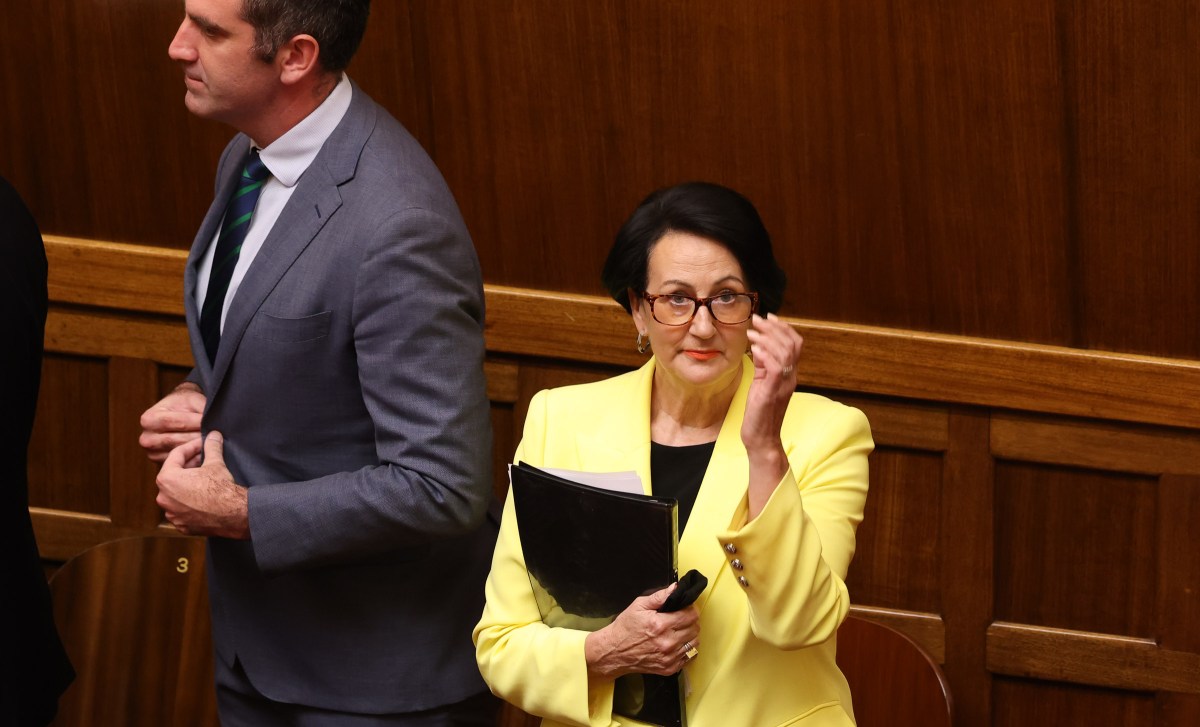
Chapman in parliament this week. Photo: Tony Lewis / InDaily
Thus, the Ombudsman leaves open the prospect of an apprehended bias – but it is beyond his purview.
And on the question of perceived conflict, he never quite arrives at a clear standard – but suggests that his hypothetical “fair and reasonable person”, in whose shoes he diligently places himself, knows far more than the average punter reading news reports of the controversy.
Indeed, he or she knows more, evidently, (or is more fair and reasonable) than even the KIPT executives who insisted after the event Chapman had, at the very least, a perceived conflict.
“It’s based on what a reasonable and fair-minded observer would perceive based on actual information and evidence,” he told me this week.
“When I put myself in the position of that reasonable and fair-minded observer, I was able to take into account all the information that was in the public arena, and what we knew about Ms Chapman’s property interests and living situation.”
He said a perceived conflict of interest “isn’t just about what it looks like from a distance” – it’s “more involved – it’s that objective reasonable observer who has looked at all the information”.
Ok then.
But it’s hard to escape the conclusion that under this definition it would be virtually impossible to ever make a finding of perceived conflict of interest, unless one can also demonstrate an actual conflict.
Lines says his report is more thorough than that of the select committee because he actually went to KI, visited the sites in question and ascertained with his own eyes that they would not be adversely affected by the proposed port development.
Is the implication that the hypothetical ‘fair and reasonable person’ must also make this trek before forming an applicable perception of conflict?
If so, well and good.
But I, like Lines, have read widely of the literature available. And this interpretation does not appear to be one that could reasonably have been formed by prospective fair and reasonable people being asked to report instances of perceived conflict across a range of public and private institutions.
For instance, a UniSA staff handbook says only that “perceived conflicts of interest include situations where it could be perceived, or appear to a reasonable person, that a staff member’s personal interests could improperly or unduly influence the performance of their duties and responsibilities”.
A paper published by Victoria’s Independent Broad-based Anti-corruption Commission by David Burfoot, a Senior Advisor to The Ethics Centre, notes the “tricky” nature of perceiving conflicts, but says: “In these situations there may be no actual or potential conflict, but someone could think (reasonably, of course) there is one and this can have its own ramifications.”
“Some argue there is no difference between perceived and actual conflicts of interest,” he goes on.
“They suggest both must be managed so best not to confuse the issue.
“I disagree. In fact, I think it is important for people, particularly public officials, to understand the difference…
“It is important to ensure officials appreciate the significance of maintaining public confidence in their integrity and that of the government – and this requires them to think differently about their accountability.”
This seems to take the ‘pub test’ approach to public accountability – but that, almost by definition, precludes Lines’ ‘highly-knowledgable reasonable person’ criteria.
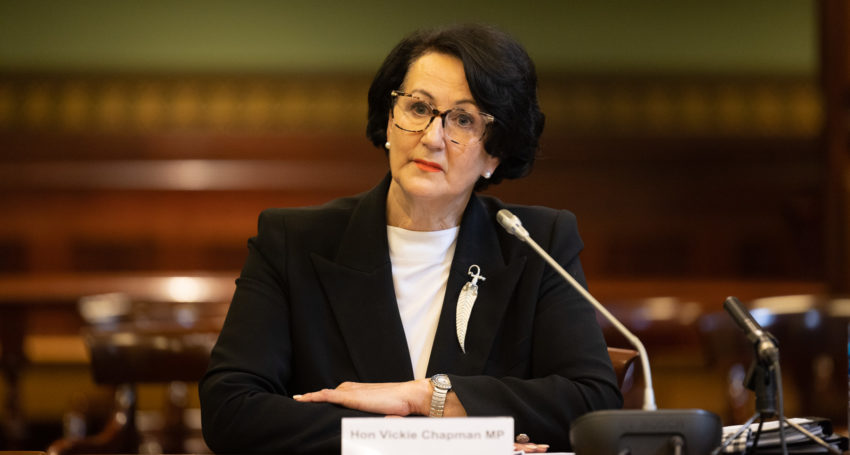
Chapman faces last year’s parliamentary inquiry, which she’s dubbed a “witch-hunt”. Photo: Tony Lewis / InDaily
Then there’s Lines’ own federal counterpart, the Office of the Commonwealth Ombudsman, whose September 2017 Conflict of Interest Guidelines state only that “conflict of interests may be real, apparent or potential”, with the relevant category being “where it appears or could be perceived that private interests are improperly influencing the performance of official duties whether or not that is actually the case”.
And of course, there’s the 1993 handbook, which so strongly informed Lines’ deliberations.
Its author was then-Attorney-General Chris Sumner.
There might be a legitimate debate about whether there was an actual conflict… but there can be none, in my view, about the appearance of conflict
The same former Attorney-General who this week declared the Ombudsman’s decision “a terrible precedent” with “far-reaching adverse implications for integrity in government”.
“There might be a legitimate debate about whether there was an actual conflict surrounding the property Chapman owned on KI but there can be none, in my view, about the appearance of conflict,” Sumner said.
“The Ombudsman has substantially downgraded the importance of government officials not having an appearance of allowing their private interests to conflict with their public duty.
“The Commissioner for Public Employment and other public sector integrity agencies will now have a difficult task to enforce proper standards of decision-making.
“The decision has also neutered the Ministerial Code – it is precisely this situation that the Code was designed to cover.”

A timber plantation on Kangaroo Island. Photo: Sean McGowan
Sumner is not alone in this view.
I have spoken to prominent members of the business community whose very understanding of perceived conflict of interest has now been shaken, and to current and former members of parliament on both sides who feel that, as one put it, the standard set for determining such a conflict is now “impossibly high – almost nothing will be a conflict”.
None of which is a reflection on Vickie Chapman, who is now exonerated.
But let’s, at least, dispense with this notion that the ‘kangaroo court’, as it will now forever be known, has robbed her of her career and ripped her from public office.
By her own admission, neither the inquiry’s findings nor the subsequent vote of no confidence prompted her to resign.
The latter, incidentally, was also predicated on parliament’s determination that she had misled the House – a decision that still stands and over which Lines has no purview.
Rather, she stepped down as deputy Liberal leader and aside from her ministries, purely because the Ombudsman had commenced his inquiry – citing “the precedent set by former Attorney-General [Michael] Atkinson”, who briefly left his ministerial posts in 2003 over suggestions, later discounted, that he’d been involved in offering nemesis Ralph Clarke board appointments in return for dropping a defamation case against him.
So insofar as her ministerial career was affected, it was only to the same degree as that little-remembered episode, after which Atkinson went on to serve another seven years as Attorney-General.
It wasn’t, then, the inquiry that curtailed Chapman’s ministerial career, but the Marshall Government’s inability to govern in a manner that would secure its re-election.
If it had, presumably she’d again be Attorney-General by now – instead of retiring at month’s end.
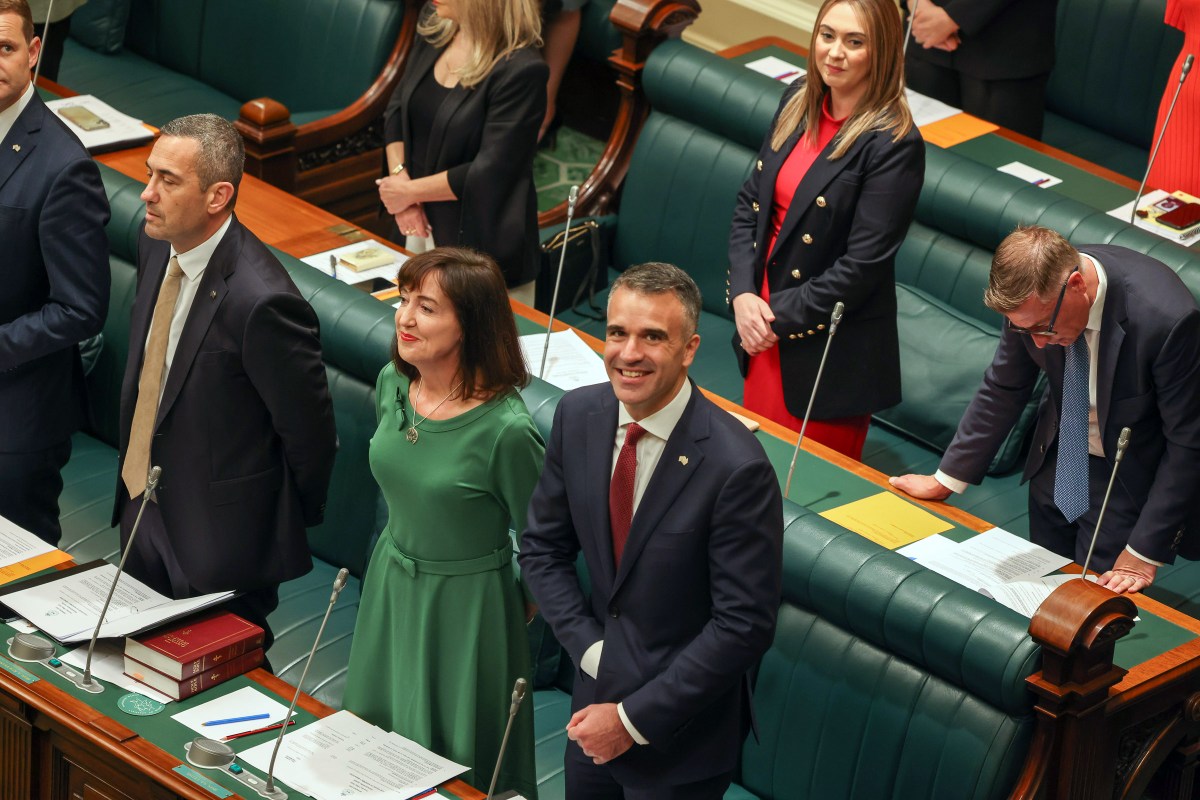
The parliament voted that Chapman had misled the House and declared no confidence in her. Photo: Tony Lewis / InDaily
She can, at least, put this episode behind her – but the state is stuck with its legacy.
For I had long believed that the notion of perceived conflict of interest was significant not merely to satisfy those involved in the process at hand – but to maintain confidence in that process for those outside it.
That, self-evidently, requires an impressionistic view of things.
But that no longer appears to be the case.
My interpretation, incidentally, was one shared by – at the very least – a noted QC, a former Attorney-General, the majority of state parliament’s House of Assembly and the current Leader of the Opposition.
And having carefully considered the Ombudsman’s findings I still can’t say it’s a view I’ve relinquished.
Still, the Ombudsman takes a different view.
And it’s the Ombudsman who was tasked with determining the matter.
So do I owe Chapman an apology?
Probably not.
But it seems churlish not to offer one. And I don’t propose to be churlish; I’ll leave that for the Labor Government.
I was firmly of the view that there was a perceived conflict of interest.
And I’ve read and considered the Ombudsman’s report – and I’m still of that view.
And for that, Vickie, I apologise.
Tom Richardson is a senior reporter at InDaily.




